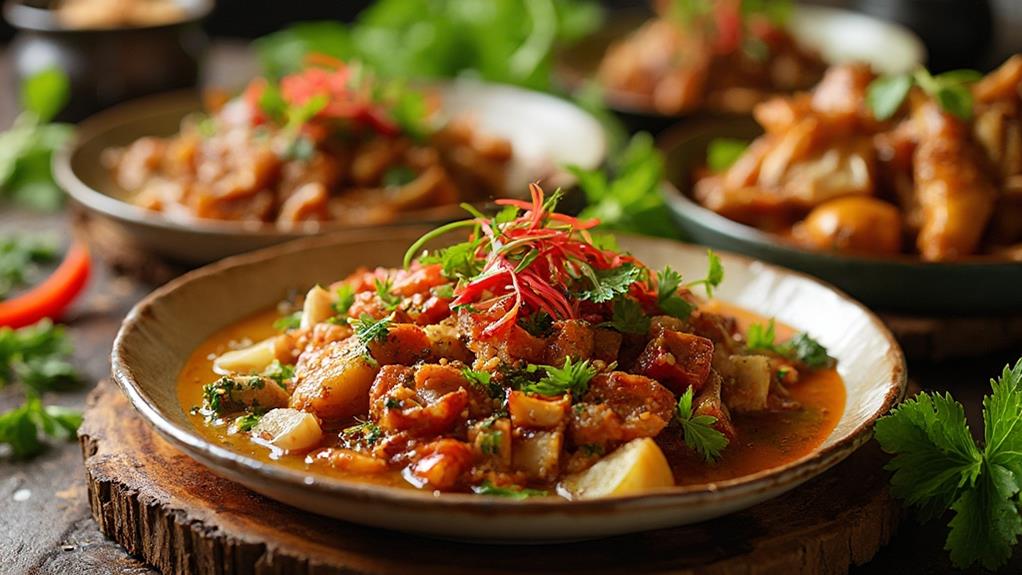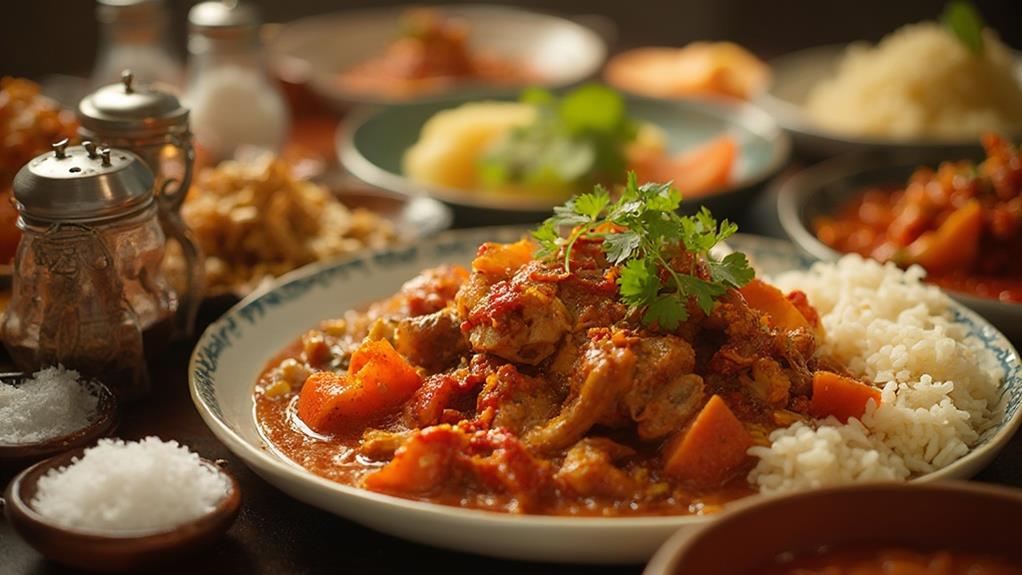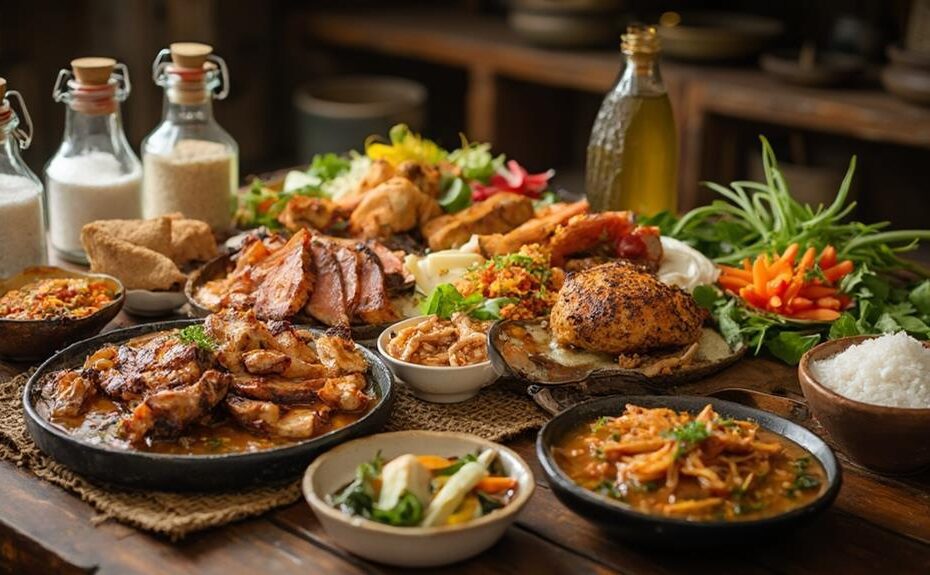Filipino dishes can be high in sodium, posing health risks. Certain dishes like adobo and sinigang often contain high levels of sodium due to ingredients like soy sauce and fish sauce.
A single serving of adobo can exceed 1,200 milligrams of sodium, which can lead to health problems like hypertension and kidney strain.
Traditional Filipino meals often contain unhealthy fats. These fats come from fatty meats and cooking methods like frying.
This can lead to elevated cholesterol levels and associated health issues. To address these concerns, using herbs for flavor, low-sodium options, leaner meats, and healthier cooking techniques can help reduce the sodium and fat content of these dishes.
Overview of Filipino Cuisine
Filipino cuisine is a fusion of different culinary traditions. This unique blend of flavors, textures, and influences reflects the country's rich history and cultural heritage. The cuisine combines indigenous ingredients with influences from Chinese, Spanish, and American traditions, showcasing the adaptability of Filipino cooks.
Rice is a staple food in Filipino cuisine. It's often paired with a variety of viands, highlighting the importance of balance in meals. For example, lechon roasting, a tradition that symbolizes celebration, is a staple in many Filipino gatherings, including the Parada Ng Lechon festival in Balayan, Batangas.
Local ingredients are emphasized in Filipino cuisine. Coconut, seafood, and tropical fruits are commonly used, emphasizing the connection to the land and sea. Each region has its own specialties, influenced by geography and climate, adding to the complexity of the cuisine.
Various cooking methods contribute to the distinctive tastes and textures. Grilling, stewing, and frying are common methods used to prepare Filipino dishes, resulting in a wide range of flavors and textures.
Common Dishes and Their Ingredients
Filipino cuisine is a rich tapestry of flavors and ingredients that reflect the nation's cultural heritage. Each dish often combines local staples like rice, vegetables, and meats, showcasing the country's agricultural bounty.
Adobo, a popular dish, primarily consists of chicken or pork marinated in vinegar, soy sauce, and garlic, which not only enhances flavor but also preserves the meat.
Sinigang features a sour broth made from tamarind, complemented by various vegetables and proteins, such as shrimp or beef. The sourness balances the richness of the meat, creating a harmonious dish.
Lechon, roasted whole pig, serves as a centerpiece at celebrations, highlighting the use of marinated pork and crispy skin.
Coconut milk is a common ingredient in many Filipino dishes, particularly in desserts like leche flan and buko pandan. This ingredient adds creaminess and richness, enhancing the overall flavor profile.
Understanding these common ingredients helps appreciate the culinary techniques and historical influences that shape Filipino cuisine, allowing for a more informed approach to enjoying and preparing these dishes.
Sodium Content in Popular Recipes

Sodium Content in Popular Filipino Dishes
When consuming traditional Filipino recipes, it's essential to be aware of their high sodium content, which can significantly impact health.
Many popular dishes, such as adobo and sinigang, contain high amounts of sodium due to the use of soy sauce, fish sauce, or salt.
A typical serving of adobo can contain upwards of 1,200 milligrams of sodium, exceeding the recommended daily limit of 2,300 milligrams for most adults.
Even soups, like sinigang, can pack a sodium punch, with around 1,000 milligrams per serving, depending on the type of seasoning used. These numbers can add up quickly, especially if you consume multiple servings or side dishes.
To manage sodium content, incorporate cooking techniques such as reducing salt or using low-sodium alternatives.
You can also boost flavor with herbs and spices, minimizing the need for salt.
Additionally, being mindful of portion sizes and the frequency of consuming these dishes will help keep sodium intake in check.
How Can I Make Traditional Filipino Dishes Healthier by Reducing Sodium and Fat?
When looking to make traditional Filipino dishes healthier, consider using alternative seasonings like herbs and spices to reduce sodium, and opt for lean proteins and healthier cooking oils to cut down on fat. Incorporating more vegetables and using cooking techniques like grilling or steaming can also create hearthealthy filipino food options.
Fat Content in Traditional Meals
Traditional Filipino meals often have high fat content due to cooking methods and ingredients. Many dishes, like lechon (roasted pig) and kare-kare (oxtail stew), include fatty cuts of meat, significantly contributing to the overall fat content.
Frying or sautéing ingredients in oil, especially coconut oil or lard, further increases the fat levels in meals.
High-fat diets can lead to various health issues, including heart disease and obesity.
The types of fats present in these dishes also matter; saturated fats, often found in animal products and certain oils, can raise cholesterol levels, posing additional health risks.
Moreover, traditional cooking practices may emphasize deep-frying, which not only adds fat but can also create unhealthy trans fats if oils are reused frequently.
To make healthier choices, consider opting for leaner cuts of meat, using less oil, or exploring cooking methods like steaming or grilling.
Health Risks Associated With High Sodium

High Sodium Levels in Traditional Filipino Dishes Pose Significant Health Risks
Consuming excessive sodium can lead to hypertension, a condition that affects nearly one in three adults. Elevated blood pressure increases the risk of heart disease and stroke, two leading causes of death globally.
Sodium Strains Kidneys and Increases Risk of Kidney Disease
High sodium intake forces kidneys to work harder to filter excess salt from the bloodstream, which can eventually lead to kidney disease.
The World Health Organization recommends limiting sodium intake to less than 2,300 milligrams per day, yet many traditional Filipino dishes exceed this amount in a single serving.
Excessive Sodium Contributes to Fluid Retention and Other Health Issues
Consuming too much sodium can cause fluid retention, leading to swelling and discomfort.
For individuals managing conditions like heart failure, low-sodium diets are often recommended to mitigate these risks.
Understanding the sodium content in meals, especially in dishes like adobo or sinigang, is crucial for making informed decisions about diet and overall well-being.
Tips for Healthier Filipino Cooking
Incorporate Fresh Ingredients and Reduce Sodium
To create healthier versions of traditional Filipino dishes, use fresh herbs and spices like ginger, garlic, and lemongrass to enhance flavor while minimizing salt.
Instead of relying on soy sauce, opt for low-sodium versions or experiment with vinegar-based marinades, which can add a tangy kick.
Boost Nutritional Content with Vegetables
When preparing dishes like adobo or sinigang, include more vegetables to boost nutritional content.
Ingredients such as spinach, eggplant, or radish increase fiber and add vibrant colors to your meals.
Choose Healthier Cooking Methods
Air-fry or bake instead of frying to significantly cut down on unhealthy fats.
When making stews, skim excess fat from the surface before serving.
Select Leaner Protein Options
Use lean cuts of meat and skinless poultry to reduce saturated fats.
This helps to make your dishes healthier and more nutritious.
Practice Portion Control
Use smaller plates to manage serving sizes effectively.
This helps to prevent overeating and maintain a healthy diet.
